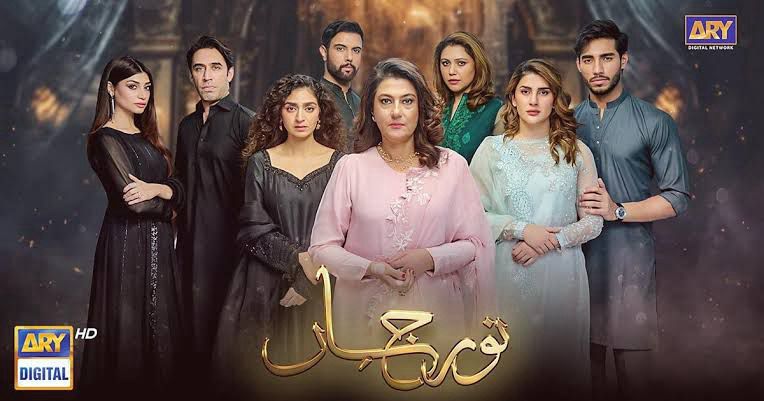

Pakistani television dramas have long explored family dynamics, with Noor Jahan stepping beyond conventional narratives. This drama intricately portrays power, authority, and hidden contradictions, using symbolic and visually stunning storytelling. At its center is Noor Jahan, the matriarch who controls and manipulates her family, driving them through emotional chaos. Each mirror, hall, and beam of light unravels layers of truth, particularly about Noor Jahan herself, whose presence drives the narrative’s emotional tension. Let’s delve deeper into how Noor Jahan masterfully intertwines tradition with modernity, exposing the cracks beneath its seemingly elegant facade.
At the heart of Noor Jahan is the tension between tradition and modernity, embodied most notably in Noor Jahan herself. As the guardian of tradition, she insists that her sons enter arranged marriages, while her own marriage was one of love—a fact she conveniently ignores. One of the clearest contradictions is seen in the way she forces her middle son, Safeer, to marry a girl of her choosing, even though he was in love with someone else. Noor Jahan’s decision to destroy Safeer’s love marriage showcases her desire to maintain control over her sons’ lives and preserve her authority.
The deepest manipulation, however, is when she arranges the marriage of her youngest son, Muraad, to Noor Bano, the daughter of her long-standing enemy. This marriage is driven by revenge, not love, as Noor Jahan seeks to settle an old score with Noor Bano’s father, who had refused to accept Noor Jahan’s marriage to Mukhtaar Shah because she wasn’t from a Syed family. This hypocrisy becomes evident to both the characters within the drama and the viewers, as Noor Jahan’s manipulative nature is revealed through these acts of control.
Noor Bano, Noor Jahan’s daughter-in-law, represents a younger generation yearning for freedom and individuality. Her frustration is palpable when she says, “Har waqt unki nazar se apne faisle dekhna, ek zindagi ko jeena nahi hai” (Living every moment under her scrutiny doesn’t feel like living). The clash between old and new, tradition and modernity, is central to the drama. Safina’s powerful monologue highlights this conflict: “Jaise har Firaun ka ek Musa hota hai, waise Noor Jahan ka Musa Noor Bano hai” (Just as every Pharaoh has a Moses, Noor Jahan’s Moses is Noor Bano). This line underscores Noor Bano’s role as a beacon of change, poised to break the oppressive shackles imposed by Noor Jahan’s rule.
The direction of Noor Jahan adds depth, using light and shadow to emphasize the story’s dichotomies. Bright, warm lighting bathes Noor Jahan in a regal glow during moments of control, while darker lighting underscores scenes of inner turmoil and emotional struggle. Wide shots of the home’s grand spaces highlight the emotional distance between the characters. As Noor Jahan moves through these expansive halls, her isolation becomes evident, reflecting her role as an unchallenged authority figure who remains emotionally disconnected from those she seeks to protect.
Mirrors in Noor Jahan are more than reflective objects; they symbolize deeper truths and vulnerabilities. Noor Jahan, masterfully and intensely portrayed by the brilliant Saba Hameed, is often seen gazing into mirrors, revealing the emotional weight she carries. In one scene, after making a life-altering decision for Muraad, Noor Jahan stares into her reflection, trying to convince herself of her righteousness. The mirror becomes a tool of self-deception, allowing her to justify her manipulations while clinging to the illusion of tradition.
Other characters, such as Noor Bano and Safina, also confront their reflections. For Noor Bano, the mirror reveals her helplessness under her mother-in-law’s oppressive influence. In Safina’s case, the mirror reflects her deep sorrow after losing her unborn child, a tragedy stemming from Noor Jahan’s favoritism. Each reflection highlights the emotional toll of Noor Jahan’s control. Safina’s poignant monologues offer raw insights into the impact of Noor Jahan’s rule. Her lines, such as “Yeh dukh itna gehra hai ke main khud ko sambhal nahi pa rahi” (This sorrow is so deep that I can’t keep myself together), convey years of repressed pain, symbolizing the suffering beneath the household’s surface.
Noor Jahan is visually extravagant, with grand halls and rich tapestries representing grandeur and family legacy. However, this grandeur stands in stark contrast to the inner conflict and tension within the mansion’s walls. Noor Jahan’s home, like her character, is luxurious and steeped in tradition. Yet beneath its beauty lies a suffocating environment where family members are trapped in a web of control and manipulation. The grandiosity of the house mirrors the expectations Noor Jahan places on her children- demanding perfection and loyalty while stifling their personal desires and freedoms.
One memorable scene takes place in the grand living room, where Noor Jahan sits, bathed in golden light, discussing love and sacrifice: “Yeh ghar sirf eent aur pathar se nahi bana, isey humari qurbani aur mohabbat ne mazboot kiya hai” (This house is not built of brick and stone alone; it has been strengthened by our sacrifices and love). Yet, her actions continuously undermine these words, enforcing a system that perpetuates emotional abuse and leaves her children powerless.
The soundtrack of Noor Jahan enhances the drama’s emotional depth, shifting between serene classical melodies and haunting, melancholic tones. The lyrics, “Akhiyan Cho Hunjua Da, Fer Daryan Nahi Sukhda, Muq Javan Saavan, Ishq Da Dard Nahi Muqda” (Tears from the eyes, the sorrow never fades, with time, the pain of love doesn’t end), capture the hidden emotional cost of living under Noor Jahan’s control.
A recurring symbol is the courtyard swing, where Noor Jahan often sits in moments of quiet reflection. The gently swaying swing represents the cyclical nature of family conflicts and the burden of leadership Noor Jahan carries. It invites the audience to contemplate her complex character, torn between maintaining tradition and the personal sacrifices she has made. In a pivotal scene, when Noor Bano intervenes and stops the swing during a family conflict, she poignantly asks, “Kya hua? Ruk gaya jhula?” (What happened? Has the swing stopped?). This moment emphasizes the disruption in the harmony of the family and reflects Noor Bano’s frustration with the oppressive dynamics upheld by Noor Jahan. Noor Bano’s act of stopping the swing symbolically represents Noor Jahan’s loss in her own game of control and manipulation.
Noor Jahan transcends the typical family drama, offering a layered exploration of matriarchal control, generational conflict, and the contradictions of upholding rigid traditions. Through nuanced characters, rich visual symbolism, and powerful dialogues- the drama challenges viewers to reflect on the cultural norms and emotional costs of living within a patriarchal structure. For those yet to experience Noor Jahan, it serves as both an engaging narrative and a thoughtful critique of the price of tradition.


All Rights Reserved © 2025 Femmerepublica. Powered by TechWrath